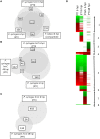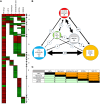Overlapping Yet Response-Specific Transcriptome Alterations Characterize the Nature of Tobacco-Pseudomonas syringae Interactions
- PMID: 27014286
- PMCID: PMC4779890
- DOI: 10.3389/fpls.2016.00251
Overlapping Yet Response-Specific Transcriptome Alterations Characterize the Nature of Tobacco-Pseudomonas syringae Interactions
Abstract
In this study transcriptomic alterations of bacterially induced pattern triggered immunity (PTI) were compared with other types of tobacco-Pseudomonas interactions. In addition, using pharmacological agents we blocked some signal transduction pathways (Ca(2+) influx, kinases, phospholipases, proteasomic protein degradation) to find out how they contribute to gene expression during PTI. PTI is the first defense response of plant cells to microbes, elicited by their widely conserved molecular patterns. Tobacco is an important model of Solanaceae to study resistance responses, including defense mechanisms against bacteria. In spite of these facts the transcription regulation of tobacco genes during different types of plant bacterial interactions is not well-described. In this paper we compared the tobacco transcriptomic alterations in microarray experiments induced by (i) PTI inducer Pseudomonas syringae pv. syringae type III secretion mutant (hrcC) at earlier (6 h post inoculation) and later (48 hpi) stages of defense, (ii) wild type P. syringae (6 hpi) that causes effector triggered immunity (ETI) and cell death (HR), and (iii) disease-causing P. syringae pv. tabaci (6 hpi). Among the different treatments the highest overlap was between the PTI and ETI at 6 hpi, however, there were groups of genes with specifically altered activity for either type of defenses. Instead of quantitative effects of the virulent P. tabaci on PTI-related genes it influenced transcription qualitatively and blocked the expression changes of a special set of genes including ones involved in signal transduction and transcription regulation. P. tabaci specifically activated or repressed other groups of genes seemingly not related to either PTI or ETI. Kinase and phospholipase A inhibitors had highest impacts on the PTI response and effects of these signal inhibitors on transcription greatly overlapped. Remarkable interactions of phospholipase C-related pathways with the proteasomal system were also observable. Genes specifically affected by virulent P. tabaci belonged to various previously identified signaling routes, suggesting that compatible pathogens may modulate diverse signaling pathways of PTI to overcome plant defense.
Keywords: Pseudomonas syringae; compatible interaction; effector triggered immunity (ETI); pattern triggered immunity (PTI); signal transduction; tobacco; transcriptome.
Figures





Similar articles
-
Effector-triggered and pathogen-associated molecular pattern-triggered immunity differentially contribute to basal resistance to Pseudomonas syringae.Mol Plant Microbe Interact. 2010 Jul;23(7):940-8. doi: 10.1094/MPMI-23-7-0940. Mol Plant Microbe Interact. 2010. PMID: 20521956
-
Dynamics of defense responses and cell fate change during Arabidopsis-Pseudomonas syringae interactions.PLoS One. 2013 Dec 11;8(12):e83219. doi: 10.1371/journal.pone.0083219. eCollection 2013. PLoS One. 2013. PMID: 24349466 Free PMC article.
-
Plant immunity directly or indirectly restricts the injection of type III effectors by the Pseudomonas syringae type III secretion system.Plant Physiol. 2010 Sep;154(1):233-44. doi: 10.1104/pp.110.159723. Epub 2010 Jul 12. Plant Physiol. 2010. PMID: 20624999 Free PMC article.
-
The PTI to ETI Continuum in Phytophthora-Plant Interactions.Front Plant Sci. 2020 Dec 17;11:593905. doi: 10.3389/fpls.2020.593905. eCollection 2020. Front Plant Sci. 2020. PMID: 33391306 Free PMC article. Review.
-
Plant immunity triggered by microbial molecular signatures.Mol Plant. 2010 Sep;3(5):783-93. doi: 10.1093/mp/ssq035. Epub 2010 Aug 16. Mol Plant. 2010. PMID: 20713980 Review.
Cited by
-
Application of Data-Independent Acquisition Approach to Study the Proteome Change from Early to Later Phases of Tomato Pathogenesis Responses.Int J Mol Sci. 2019 Feb 17;20(4):863. doi: 10.3390/ijms20040863. Int J Mol Sci. 2019. PMID: 30781546 Free PMC article.
-
Transcriptome changes in Arabidopsis thaliana infected with Pseudomonas syringae during drought recovery.Sci Rep. 2017 Aug 22;7(1):9124. doi: 10.1038/s41598-017-09135-y. Sci Rep. 2017. PMID: 28831155 Free PMC article.
-
Diverse Effect of Two Cytokinins, Kinetin and Benzyladenine, on Plant Development, Biotic Stress Tolerance, and Gene Expression.Life (Basel). 2021 Dec 15;11(12):1404. doi: 10.3390/life11121404. Life (Basel). 2021. PMID: 34947935 Free PMC article.
-
Chloroplast Redox Status Modulates Genome-Wide Plant Responses during the Non-host Interaction of Tobacco with the Hemibiotrophic Bacterium Xanthomonas campestris pv. vesicatoria.Front Plant Sci. 2017 Jul 4;8:1158. doi: 10.3389/fpls.2017.01158. eCollection 2017. Front Plant Sci. 2017. PMID: 28725231 Free PMC article.
-
A pattern-triggered immunity-related phenolic, acetosyringone, boosts rapid inhibition of a diverse set of plant pathogenic bacteria.BMC Plant Biol. 2021 Mar 25;21(1):153. doi: 10.1186/s12870-021-02928-4. BMC Plant Biol. 2021. PMID: 33765920 Free PMC article.
References
-
- Albrecht C., Boutrot F., Segonzac C., Schwessinger B., Gimenez-Ibanez S., Chinchilla D., et al. (2012). Brassinosteroids inhibit pathogen-associated molecular pattern-triggered immune signaling independent of the receptor kinase BAK1. Proc. Natl. Acad. Sci. U.S.A. 109, 303–308. 10.1073/pnas.1109921108 - DOI - PMC - PubMed
LinkOut - more resources
Full Text Sources
Other Literature Sources
Miscellaneous

